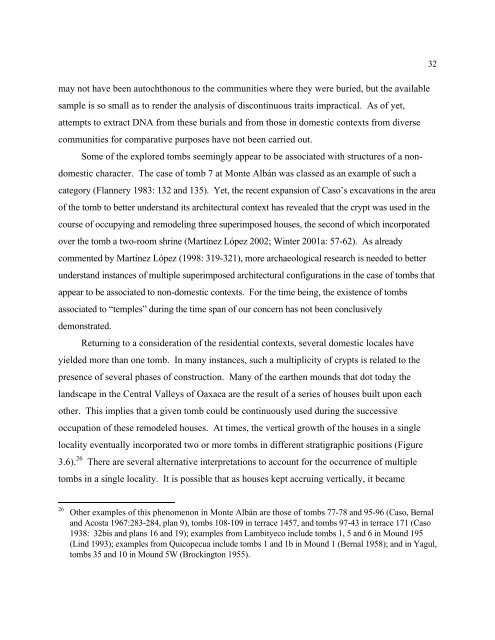Create successful ePaper yourself
Turn your PDF publications into a flip-book with our unique Google optimized e-Paper software.
may not have been autochthonous to the communities where they were buried, but the available<br />
sample is so small as to render the analysis of discontinuous traits impractical. As of yet,<br />
attempts to extract DNA from these burials and from those in domestic contexts from diverse<br />
communities for comparative purposes have not been carried out.<br />
Some of the explored tombs seemingly appear to be associated with structures of a non-<br />
domestic character. The case of tomb 7 at Monte Albán was classed as an example of such a<br />
category (Flannery 1983: 132 and 135). Yet, the recent expansion of Caso’s excavations in the area<br />
of the tomb to better understand its architectural context has revealed that the crypt was used in the<br />
course of occupying and remodeling three superimposed houses, the second of which incorporated<br />
over the tomb a two-room shrine (Martínez López 2002; Winter 2001a: 57-62). As already<br />
commented by Martínez López (1998: 319-321), more archaeological research is needed to better<br />
understand instances of multiple superimposed architectural configurations in the case of tombs that<br />
appear to be associated to non-domestic contexts. For the time being, the existence of tombs<br />
associated to “temples” during the time span of our concern has not been conclusively<br />
demonstrated.<br />
Returning to a consideration of the residential contexts, several domestic locales have<br />
yielded more than one tomb. In many instances, such a multiplicity of crypts is related to the<br />
presence of several phases of construction. Many of the earthen mounds that dot today the<br />
landscape in the Central Valleys of Oaxaca are the result of a series of houses built upon each<br />
other. This implies that a given tomb could be continuously used during the successive<br />
occupation of these remodeled houses. At times, the vertical growth of the houses in a single<br />
locality eventually incorporated two or more tombs in different stratigraphic positions (Figure<br />
3.6). 26 There are several alternative interpretations to account for the occurrence of multiple<br />
tombs in a single locality. It is possible that as houses kept accruing vertically, it became<br />
26 Other examples of this phenomenon in Monte Albán are those of tombs 77-78 and 95-96 (Caso, Bernal<br />
and Acosta 1967:283-284, plan 9), tombs 108-109 in terrace 1457, and tombs 97-43 in terrace 171 (Caso<br />
1938: 32bis and plans 16 and 19); examples from Lambityeco include tombs 1, 5 and 6 in Mound 195<br />
(Lind 1993); examples from Quicopecua include tombs 1 and 1b in Mound 1 (Bernal 1958); and in Yagul,<br />
tombs 35 and 10 in Mound 5W (Brockington 1955).<br />
32

















